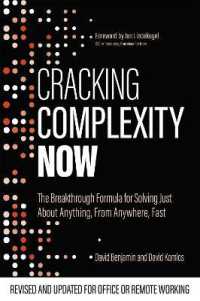Full Description
Widely praised for its conversational tone and clear advice, Practically Speaking is the public speaking textbook your students will actually read. Filled with engaging stories and examples, sound scholarship and recent research, and useful tips and tricks, Practically Speaking shows students how to get started, practice thinking critically, and ultimately develop their own voice.
Contents
ContentsPrefaceChapter 01: Communication Competence and Public SpeakingDefining CommunicationCommunication as a Transactional Process: Working with an AudienceCommunication as Sharing Meaning: Making Sense Defining Communication Competence in Public SpeakingEffectiveness: Achieving GoalsDegrees of Effectiveness: From Deficient to ProficiencyAudience Orientation: You Are Not Talking to YourselfAppropriateness: Speaking by the RulesAchieving Competent Public SpeakingKnowledge: Learning the RulesSkills: Showing Not Just KnowingSensitivity: Developing Receptive AccuracyCommitment: Acquiring a Passion for Excellence Ethics: Determining the Right and Wrong of SpeakingEthical Standards: Judging Moral Correctness of SpeechPlagiarism: Never InconsequentialSummaryTed Talks and YouTube VideosChecklistChapter 02: Speech AnxietySpeech Anxiety as a ChallengePervasiveness of Speech Anxiety: A Common ExperienceSymptoms: Flight-or-Flight ResponseBasic Symptoms: Your Body's Response to ThreatAppropriateness of Symptoms: Relevance to Public SpeakingCauses of Dysfunctional Anxiety and Basic StrategiesSelf-Defeating Thoughts: Sabotaging Your SpeechCatastrophic Thinking: Fear of FailurePerfectionist Thinking: No Mistakes PermittedDesire for Complete Approval: Trying Not to OffendThe Illusion of Transparency: Being Nervous about Looking NervousAnxiety-Provoking Situations: Considering ContextNovelty of the Speaking Situation: UncertaintyConspicuousness: In the SpotlightTypes of Speeches: Varying ResponsesStrategies for Managing Speech AnxietyPrepare and Practice: Transforming Novelty into FamiliarityGain Realistic Perspective: Rational Not Irrational ThinkingAdopt a Noncompetitive Communication Orientation: ReframingUse Coping Statements: Rational ReappraisalUse Positive Imaging: Visualizing SuccessUse Relaxation Techniques: Reducing Fight-or-Flight ResponseTry Systematic Desensitization: Incremental RelaxationSummaryTed Talks and YouTube VideosChecklistChapter 3. Audience AnalysisTypes of AudiencesCaptive Audience: Disengaged ListenersCommitted Audience: Agreeable ListenersContrary Audience: Hostile ListenersConcerned Audience: Eager ListenersCasual Audience: Unexpected ListenersAudience CompositionAge: Possible Generation GapsGender: Go Beyond Simplistic StereotypesEthnicity and Culture: Sensitivity to DiversityGroup Affiliations: A Window into Listeners' ViewsAdapting to Diverse AudiencesEstablish Identification: Connecting with Your AudienceLikeability: I Can Relate to YouStylistic Similarity: Looking and Acting the PartSubstantive Similarity: Establishing Common GroundBuild Credibility: Establishing BelievabilityAdapt to the Situation: Influence of Circumstances Adapt While Speaking: Exhibit SensitivityTopic Choice and Audience AdaptationExploring Potential Topics: Important ChoiceDo a Personal Inventory: You as Topic SourceBrainstorm: New PossibilitiesCrowdsourcing for Topics: Group WisdomScanning for Topics: Quick IdeasAppropriateness of Topic: Blending Topic and AudienceSpeaker Appropriateness: Suitability for YouAudience Appropriateness: Suitability for Your ListenersOccasion Appropriateness: Suitability for the EventNarrowing the Topic: Making Subjects ManageableSummaryTed Talks and YouTube VideosChecklistChapter 4. Gathering MaterialThe Internet: Online ResearchSearch EnginesDirectoriesMetasearch EnginesVirtual LibrariesGovernment SitesSurvey SitesInternet Search TipsWikipedia: Credible Scholarship or Mob Rule?Blogging Sites: Be Very ChoosyFamous Quotation Sties: The Wisdom of OthersEvaluating Internet Information: Basic StepsLibraries: Bricks-and-Mortar Research FacilitiesLibrarian: Expert NavigatorLibrary Catalogues: Computer VersionsPeriodicals: Popular Information SourcesNewspapers: An Old StandbyReference Works: Beyond WikipediaDatabases: Computerized Collections of Credible InformationInterviewing: Questioning ExpertsInterview Plan: Be PreparedInterview Conduct: Act AppropriatelyInterviewing by Email: Surprise YourselfSummaryTed Talks and YouTube VideosChecklistChapter 5. Using Supporting Materials Effectively Using Examples CompetentlyTypes of Examples: Specific IllustrationsHypothetical Examples: It Could HappenReal Examples: It Did HappenBrief Examples: Short and to the PointExtended Examples: Telling a StoryUsing Examples Effectively: Choose CarefullyUse Relevant Examples: Stay on PointChoose Vivid Examples: Create ImagesUse Representative Examples: Reflect What Is AccurateStack Examples: When One Is Not EnoughUsing Statistics CompetentlyMeasures of Central Tendency: Determining What Is TypicalMean: Your Average StatisticMedian: An in-the-Center StatisticMode: Most Frequent StatisticHow to Use Statistics Effectively: Beyond Numbing NumbersUse Accurate Statistics Accurately: No DistortingMake Statistics Concrete: Meaningful NumbersMake Statistical Comparisons: Gaining PerspectiveStack Statistics: Creating ImpactUse Credible Sources: Build BelievabilityUsing Testimony CompetentlyTypes of Testimony: Relying on OthersTestimony of Experts: Relying on Those in the KnowEyewitness Testimony: You Had to Be ThereTestimony of Non-Experts: Ordinary Folks Adding Color to EventsHow to Use TestimonyQuote or Paraphrase Accurately: Consider ContextUse Qualified Sources: Credibility MattersGeneral Considerations across TypesChoose Interesting Supporting Materials: Counteracting BoredomCite Sources Completely: No Vague ReferencesAbbreviate Source Citations: Brief Reference RemindersCombine Examples, Stats, and Quotes: The Power of ThreeSummaryTed Talks and YouTube VideosChecklistChapter 6. Attention: Getting People to ListenNature or AttentionSelective Attention of Listeners: Filtering StimuliMindful Listening: Focused Attention[Box Feature] Developing Competence in Public Speaking: How to Be a Mindful SpeakerAttention Strategies: Triggering ListeningNovelty: The Allure of the NewUnusual Topics: Choosing Outside the BoxUnusual Examples: The Anti-SedativeUnusual Stories: Nothing Like a Good TaleUnusual Phrasing: It Is in the WordingStartling Appeal: Shake up Your ListenersStartling Statements, Facts, or Statistics: The "Oh WOW" EffectInappropriate Use: Beware Bizarre BehaviorThe Vital Appeal: MeaningfulnessHumorous Appeal: Keep Listeners LaughingDo Not Force Humor: Not Everyone Is FunnyUse Only Relevant Humor: Stay FocusedBe Sensitive to Audience and Occasion: Humor Can BackfireConsider Using Self-Deprecating Humor: "I'm Not Worthy"Movement and Change: Our Evolutionary ProtectionIntensity: Extreme Degree of a StimulusSummaryTed Talks and YouTube VideosChecklistChapter 7. Introductions and ConclusionsObjectives for Competent IntroductionsGain Attention: Focusing Your ListenersBegin with a Clever Quotation: Let Others Grab AttentionUse Questions: Engage Your ListenersTell a Relevant Story: Use Narrative PowerBegin with a Simple Visual Aid: Show and TellRefer to Remarks of Introduction: Acknowledging PraiseMake A Clear Purpose Statement: Providing IntentEstablish Topic Significance: Making Your Listeners CareEstablish Your Credibility: Why Listeners Should Believe YouPreview The Main Points: The Coming AttractionsObjectives for Competent ConclusionsSummarize The Main Points: Connecting The DotsRefer to the Introduction: Bookending Your SpeechMake a Memorable Finish: Sizzle Do Not FizzleSummaryTed Talks and YouTube VideosChecklistChapter 8. Outlining and Organizing SpeechesEffective OutliningStandard Formatting: Using Correct SymbolsDivision: Dividing the PieCoherence: Logical Consistency and ClarityCompleteness: Using Full SentencesBalance: No Lopsided Time Allotment[Box Feature] A Student Outline: Rough Draft and RevisionEffective Organization: Creating PatternsTopical Pattern: By the SubjectsChronological Pattern: According to TimeSpatial Pattern: VisualizationCausal Pattern: Who or What Is ResponsibleProblem-Solution Pattern: Meeting NeedsProblem-Cause-Solution Pattern: Knowing Why and HowComparative Advantages Pattern: Who or What Is BetterMonroe's Motivated Sequence: Five-Step PatternNarrative Pattern: Telling a StoryConnecting the Dots: Additional TipsProvide DefinitionsUse SignpostsMake TransitionsUse Internal PreviewsGive Internal SummariesPreparation Versus Presentation OutlinesSummaryTed Talks and YouTube VideosChecklistChapter 9. Speaking Style: Using LanguageOral Versus Written StyleStyle in the Electronic AgeStandards of Competent Oral StyleClarity: Saying What You MeanPrecision: Picking the Apt WordsVividness: Painting a PictureMetaphor and Simile: Figures of SpeechAlliteration: Several of the Same SoundsRepetition: Rhythmic CadenceAntithesis: Using OppositesSummaryTed Talks and YouTube VideosChecklistChapter 10. Delivering Your SpeechMethods of Competent DeliveryManuscript Speaking: Looking for PrecisionMemorized Speaking: Memory Do Not Fail Me NowImpromptu Speaking: Off-the-Cuff PresentationsExtemporaneous Speaking: The Virtues of an OutlineDeveloping Competent DeliveryEye Contact: Connecting with Your AudienceVoice: Developing Vocal VarietyFluency: Avoiding Excessive Vocal FillersSpeaking Rate: Finding the Right PaceArticulation and Pronunciation: Striving for Clarity of SpeechBody Movements: Finding the Right BalancePodium Usage: Avoiding the Lectern LeanMicrophone Usage: Amplifying Your DeliveryDistracting Behaviors: Avoiding InterferenceAudience-Centered Delivery: Matching the ContextSummaryTed Talks and YouTube VideosChecklistChapter 11. Visual AidsBenefits of Visual Aids: Reasons to Use ThemTypes of Visual Aids: Making Appropriate ChoicesObjects: Show and TellModels: Practical RepresentationsGraphs: Making Statistics Clear and InterestingMaps: Making a Point GeographicallyTables: Factual and Statistical ComparisonsPhotographs: Very Visual AidsDrawings: Photo SubstitutesVisual Aids Media: Simple to Technologically AdvancedChalkboard and Whiteboard: All Dinosaurs Are Not ExtinctPoster Board: Simplicity ItselfHandouts: An Old StandbyVideo Excerpts: DVDs, YouTube, and Visual PowerProjection Equipment: Blowing It UpComputer-Assisted Presentations: PowerPoint[Box Feature] PowerPoint: Lots of Power, Little Point?Guidelines for Competent Use: Aids Not DistractionsKeep Aids SimpleMake Aids VisibleMake Aids Neat, Attractive, and AccurateDo Not Block the Audience's ViewKeep Aids Close to YouPut the Aid Out of Sight When Not in UsePractice with AidsDo Not Circulate Your AidsDo Not Talk in the DarkAnticipate ProblemsSummaryTed Talks and YouTube VideosChecklistChapter 12. Skepticism: Becoming Critical Thinking Speakers and ListenersSkepticism, True Belief, and CynicismDangers of True BeliefThe Process of True BelievingConfirmation Bias: Searching for SupportRationalization of Disconfirmation: Clinging to FalsehoodsShifting the Burden of Proof: Whose Obligation Is It?The Process of Skepticism: Inquiring Minds Want to KnowProbability Model: Likely but Not CertainPossibility: Could Happen, but Do Not Bet on ItPlausibility: Making a Logical CaseProbability: What Are the Odds?Certainty: Without ExceptionSkepticism and Open-Mindedness: Inquiring Minds, Not Empty MindsSummaryTed Talks and YouTube VideosChecklistChapter 13. Argument, Reasoning, and EvidenceAn Argument: Staking Your ClaimSyllogism: Formal LogicToulmin Structure of Argument: Informal LogicCriteria for Reasoning and Evidence: Is It Fact or Fallacy? Credibility: Should We Believe You?Manufactured or Questionable Statistics: Does It Make Sense? Biased Source: Grinding an AxExpert Quoted Out of Field: No Generic Experts AllowedRelevance: Does It Follow?Ad Hominem Fallacy: Diversionary TacticAd Populum Fallacy: Arguing from Public OpinionSufficiency: Got Enough?Self-Selected Sample: Partisan PowerInadequate Sample: Large Margin of ErrorHasty Generalization: Arguing from ExampleCorrelation Mistaken for Causation: X Does Not Necessarily Cause YFalse Analogy: Mixing Apples and OrangesSummaryTed Talks and YouTube VideosChecklistChapter 14. Informative SpeakingDistinguishing Informative from Persuasive SpeakingNoncontroversial Information: Staying NeutralPrecursor to Persuasion: No Call to ActionTypes of Informative SpeechesReports: Facts in BriefExplanations: Deeper UnderstandingDemonstrations: Acting OutNarratives: StorytellingSpeeches that Compare: Balancing the Pros and ConsGuidelines for Competent Informative SpeakingBe Informative: Tell Us What We Do Not KnowAdapt to Your Audience: Topic Choice and Knowledge BaseAvoid Information Overload: Beware the Data DumpTell Your Story Well: Narrative TipsSummaryTed Talks and YouTube VideosChecklistChapter 15. Foundations of Persuasive SpeakingDefining PersuasionGoals of PersuasionConversion: Radical PersuasionModification: Do Not Ask for the MoonMaintenance: Keep 'Em Coming BackAttitude-Behavior ConsistencyDirect Experience: No Second-Hand AttitudesSocial Pressure: Getting Heat from OthersEffort Required: Degree of DifficultyElaboration Likelihood ModelPropositions: Fact, Value, and Policy ClaimsCulture and PersuasionSummaryTed Talks and YouTube VideosChecklistChapter 16. Persuasive Speaking StrategiesEnhance the Speaker: Identification and CredibilityUse Logic and Evidence: A Persuasive FocusPersuasive Arguments: Quality and QuantityPersuasive Evidence: Statistics versus NarrativesTry Emotional Appeals: Beyond LogicGeneral Emotional Appeals: Motivating ChangeFear Appeals: Are You Scared Yet?Anger Appeals: Moderately UpsetEthics and Emotional Appeals: Is It Wrong To Be Peripheral?Frame Your Case: Shaping Attitude and Behavior with LanguageInduce Cognitive Dissonance: Creating TensionUse the Contrast Effect: Minimize the MagnitudeUse a Two-Sided Organizational Pattern: RefutationSummaryTed Talks and YouTube VideosChecklistChapter 17. Speeches for Special OccasionsTribute AddressesToasts: Raising a Glass in TributeRoasts: Poking Fun with AdmirationTribute to Colleagues: Honoring the DepartingEulogies: Praising the DepartedIntroductions of Featured SpeakersSpeeches of PresentationSpeeches of AcceptanceCommencement AddressesAfter-Dinner SpeechesSummaryTed Talks and YouTube VideosChecklistAppendix A Text of an Informative Speech: "The Annual Plague" Appendix B Text of a Persuasive Speech: "Get Big Money Out of College Sports"








